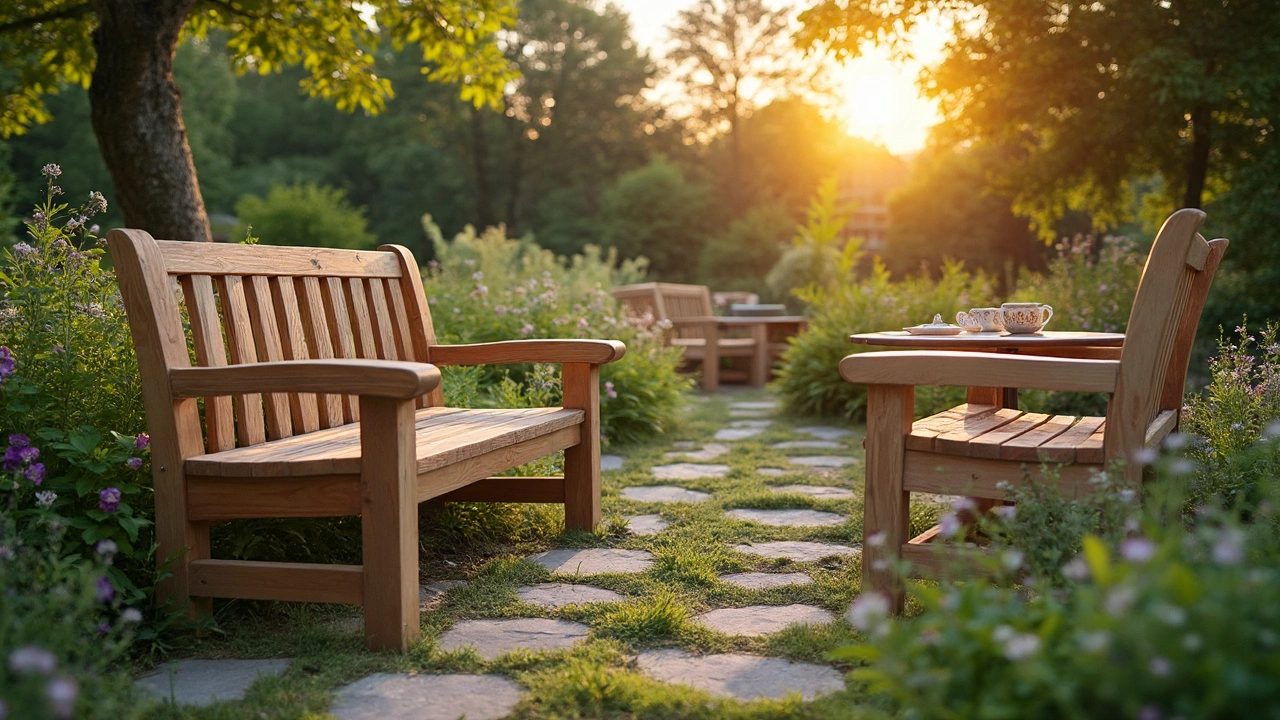 15
Jun,2025
15
Jun,2025
When people shop for garden furniture that’s both sturdy and eco-friendly, POLYWOOD pops up everywhere. It's famous for being made from recycled plastics and lasting for years with hardly any fuss. But there's a twist—some of the best outdoor furniture comes from Amish craftsmen, known for sticking to old-school skills and no-frills designs.
If you’ve ever stepped into a shop claiming “Amish-made POLYWOOD furniture,” you might start to wonder: does this even line up with Amish traditions? Does the Amish community, famously low-tech, actually use something as modern as recycled plastic lumber?
It’s easy to assume all Amish furniture is oak or cedar, but the full story isn’t so black and white. Let’s get into what really happens behind those garden benches—and why you might actually see the Amish name attached to POLYWOOD pieces.
- What Is POLYWOOD and Why Is It Popular?
- Amish Craftsmanship: What Materials Do They Use?
- Do Amish Builders Actually Use POLYWOOD?
- Tips for Picking the Best Outdoor Furniture
What Is POLYWOOD and Why Is It Popular?
POLYWOOD seems like a fancy name, but it’s basically recycled plastic made to look and feel like wood. Imagine old milk jugs, detergent bottles, and other HDPE plastics—they’re melted down and shaped into outdoor furniture parts. This keeps junk out of landfills and cuts down on the need to chop trees for building chairs or tables.
The big draw? POLYWOOD lasts way longer outside compared to real wood. It doesn’t rot, doesn’t splinter, and doesn’t need to be sealed or painted every year. You can leave it in the sun, rain, or snow, and it won’t crack or fade like your old wood picnic table did. If you’ve got kids or pets, you’ll love that it wipes clean with just soap and water—no special cleaner needed.
Some folks worry about plastic furniture looking cheap. That’s not really the case here. POLYWOOD is chunky and solid. Plus, it’s heavy enough not to blow away in a storm. It also comes in lots of colors—think classic white, forest green, or deep blue—so you don’t have to settle for just plain wood tones.
Here’s the cool part: POLYWOOD is one of the original brands, but other companies now make plastic lumber with the same idea. Still, most people call all of this stuff "POLYWOOD" the same way folks say "Kleenex" for tissues.
How does POLYWOOD really stack up against natural wood or cheap plastic from the hardware store? Take a look at some clear facts:
| Material | Expected Outdoor Life | Maintenance | Resists Splintering & Rot | Made from Recycled Content |
|---|---|---|---|---|
| POLYWOOD | 15+ years | Low—just soap and water | Yes | Yes (mostly HDPE plastics) |
| Hardwood | 10-20 years (with upkeep) | High—seal, stain, sand | No | No |
| Cheap Plastic | 1-3 years | Low | Usually cracks or fades | Sometimes |
If you want outdoor furniture that’s easy, looks good, and doesn’t need babysitting, POLYWOOD’s tough to beat. That’s why it’s all over porches and patios now—especially for folks who want something sustainable.
Amish Craftsmanship: What Materials Do They Use?
The Amish have a rep for classic woodworking, no doubt. If you walk through an Amish workshop, you’ll see stacks of hardwoods like oak, cherry, and maple. These woods aren’t just popular for looks—their durability makes them perfect for garden furniture that lasts through endless seasons. Amish builders pick their materials with care, often choosing local or regionally sourced lumber to keep the quality high and support their communities.
Their work mostly sticks to wood, but there are some newer twists. While hand tools and simple machinery power most Amish shops, the furniture isn’t stuck in the past. In certain places—especially outside stricter Old Order groups—Amish craftsmen do use treated pine (popular for outdoor benches) and even cedar for its bug-resistant, weather-friendly qualities.
You’ll also spot Amish-made pieces with poly lumber or recycled plastics, but not everywhere. It depends on the community's rules (some stick with pure wood, while others bend for modern, eco-friendly choices). Here’s a quick look at what gets used most:
- Amish builders prefer oak, cherry, hickory, and maple for strength and appearance
- Cedar is a top pick when they want natural weather resistance
- Treated yellow pine shows up in outdoor swings and picnic tables
- Some shops use poly lumber (like POLYWOOD), but this varies by community
Handmade details still matter—dovetail joints, hand-sanded edges, solid frames. The Amish won’t rush a job just to save time or money, and you feel it when you heft a true Amish-built chair.
| Material | Common Use | Weather Resistance |
|---|---|---|
| Oak | Benches, tables, swings | Good with stain/sealant |
| Maple | Chairs, indoor pieces | Fair, not great outdoors |
| Cedar | Outdoor furniture, chests | High, naturally repels bugs |
| Treated Pine | Swings, picnic tables | High, after treatment |
| Poly Lumber | Adirondack chairs, tables | Excellent, no maintenance |
If you want that real Amish look but less maintenance, shops using poly lumber make sense, and some even give you color options you won’t get with wood.

Do Amish Builders Actually Use POLYWOOD?
Here’s the scoop: Some Amish builders do use POLYWOOD, but it’s not as simple as all Amish saying yes or no. POLYWOOD, the brand, is made from recycled high-density polyethylene (HDPE)—think milk jugs turned into lumber. There’s real debate in Amish communities about new materials and technology in general, but the furniture business is a bit of a special case.
If you visit Amish-owned workshops in Ohio, Indiana, or Pennsylvania—the big three—they might advertise outdoor furniture made from "poly lumber." This doesn’t always mean the official POLYWOOD brand, but it’s basically the same stuff. Amish craftsmen realized that poly lumber lasts decades, resists rot, and handles rain without breaking a sweat. For garden furniture beaten by the elements, that’s huge.
Not every Amish family is on board, though. Old Order Amish mostly stick with classic woods like cedar or oak because they want to keep things traditional. New Order and more progressive Amish are willing to run a few power tools off generators and accept new materials if customers want them. A lot of the poly outdoor sets you’ll see at "Amish" stores are built by those more open groups.
Let’s get specific. A 2022 survey from an Indiana Amish furniture market showed that about 40% of shops offered poly options. That number jumps to 70% near tourist areas where outdoor living is big business. The pieces are still built by hand, but now the builders use poly lumber instead of just wood.
| Area | % of Amish Shops Using Poly Lumber |
|---|---|
| Rural Midwest | 30% |
| Tourist Hotspots (PA, Ohio, IN) | 70% |
| Old Order Amish Areas | 10% |
| Modern/Progressive Amish Areas | 60% |
Shoppers do need to watch out, though. Sometimes, a store says their poly furniture is Amish-made when it’s actually mass-produced elsewhere and just branded that way. To be sure, ask about the builder or look for certifications from trusted Amish workshops.
The bottom line: Amish builders who want to stay competitive—and meet customer demand for weatherproof garden furniture—do use POLYWOOD and similar materials, but it depends on which Amish group and where they live. The work is still handcrafted, and the classic Amish look is still there. The material has just gone from tree to recycled bottle.
Tips for Picking the Best Outdoor Furniture
Choosing outdoor furniture isn’t just about what looks good lined up on your patio. If you want something that lasts through summer heatwaves and winter freezes, it pays to check the facts before you buy. Here’s a no-nonsense guide to help you make a solid choice.
- Amish furniture is well-known for tough, old-school joinery and real-wood vibes, but there are other good options if you want zero maintenance—like POLYWOOD and other recycled plastic materials.
- Check the material. Teak and cedar handle the weather better than pine. POLYWOOD doesn’t need staining or sealing and doesn’t rot or splinter.
- Think about weight. Heavy-duty pieces (like genuine Amish wood benches) stay put in the wind. Lightweight aluminum might blow away unless you anchor it.
- Consider comfort. Sounds obvious, but a bench or chair that’s just for looks isn’t worth your money. Try to sit before you buy or read reviews from folks who actually use it.
- If you care about sustainability, ask questions: Is the wood FSC-certified? Is the plastic recycled? Furniture backed by responsible resources pays off long-term.
- Hardware matters, too. Look for stainless steel or brass to avoid ugly rust stains down the road.
If you want the quick lowdown on how different materials stand up outside, check out this table:
| Material | Weather Resistance | Maintenance | Average Lifespan |
|---|---|---|---|
| Teak | Excellent | Low (occasional oiling) | 20+ years |
| Cedar | Good | Moderate (may need sealant) | 15-20 years |
| Pine | Poor–Moderate | High (requires paint or stain) | 5–10 years |
| POLYWOOD/Recycled Plastic | Excellent | Zero (just wash occasionally) | 20+ years |
| Aluminum | Excellent | Low (may need washing) | 15+ years |
One of the easiest ways to pick winners? Stick to brands or artisans with solid reputations. If you’re tossing up between old-school Amish woodwork and modern POLYWOOD, think about how much time you want to spend on upkeep. In the end, the best garden furniture is the one you actually use and enjoy every sunny day—not just something pretty you end up covering up.




